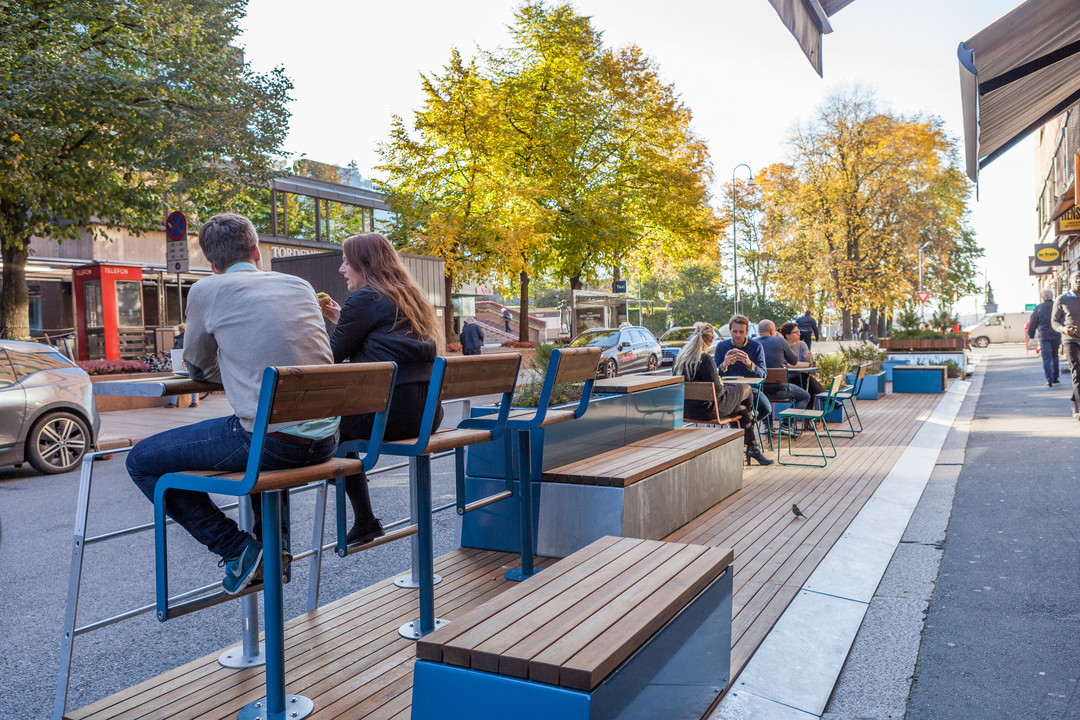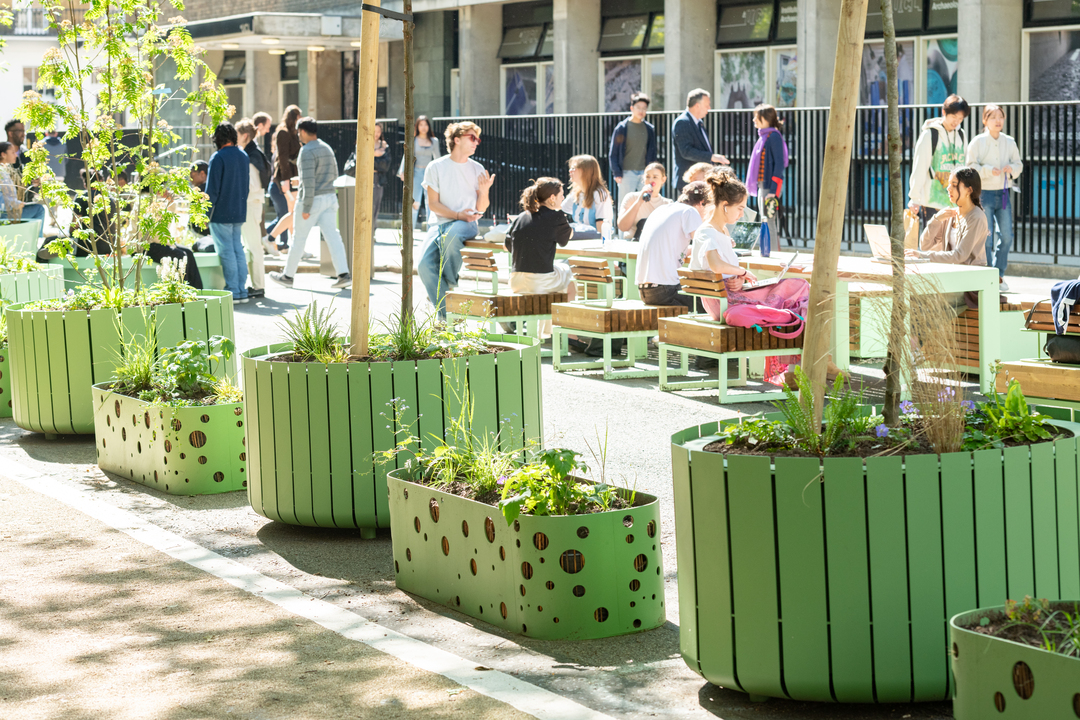
Billboard
Skyscrapper
Halfpage
There is great potential for green spaces in urban areas, but it is not being fully utilized. This is where Vestre comes in with its outdoor furniture. In an interview with Julia Pültz, Commercial Director Central Europe at Vestre, it quickly becomes clear what the street furniture company stands for.
Creating sustainable meeting places
Julia Pültz, climate adaptation and climate protection have become political buzzwords worldwide. How important do you think climate adaptation and climate protection really are in international politics and city administration? What is your impression?
It’s good that we are starting to talk about climate challenges generally. It is no longer possible to ignore them. They must therefore be at the top of the political agenda, if only because of public pressure. However, the actual importance and the associated willingness to invest vary greatly from region to region. Some cities and countries have made significant progress and are taking their commitments seriously to meet the 1.5-degree target of the Paris Agreement and to create a liveable environment adapted to the new conditions.
This includes the creation of socially sustainable meeting places that have a positive impact on the urban climate by promoting car-free zones, reducing land sealing and supporting biodiversity through green spaces and planting.
Such spaces foster community, improve quality of life and contribute to climate resilience. It is vital that policy makers and city councils adopt this holistic perspective and actively invest in projects that deliver both environmental and social benefits.

Search for low-carbon solutions
Which projects and strategies do politics and society absolutely need to tackle in order to actually fight climate change in the city? How would you prioritise them?
That’s a bold question, Theresa! What all my points have in common is the need for strong political commitment and the need for close cooperation between public authorities, civil society and the private sector.
In general it is about decarbonising and seeking low-carbon solutions, managing the materials better with circular solutions and making it easier to move around with lower footprints.
For example:
- Energy-efficient renovation of buildings: Energy efficiency measures and the use of renewable energy are now usually an integral part of sustainable urban planning. For me, however, the concept of urban mining is essential. We need to internalise this extra step as standard practice and understand buildings as material stores. Urban mining makes it possible to extract and reuse raw materials from existing buildings and urban infrastructure. Platforms such as Concular promote the efficient reuse of materials from demolition projects.
- Promoting green infrastructure in urban areas: parks, green roofs and vertical gardens make a significant contribution to reducing urban heat islands and improving air quality. Green infrastructure increases biodiversity, stores CO2 and provides valuable recreational areas for the population. They also promote social interaction and the well-being of city dwellers.
- Sustainable mobility: Investing in public transport, increasing cycle paths and creating pedestrian zones are essential to reducing CO2. The concept of car-free cities/districts and the promotion of shared mobility also contribute to the desired reduction in private transport.


High-quality products
The recently published Vestre Impact report 2023 has defined a concrete decarbonisation plan for the company. Your goal is to be known as the world’s most sustainable street furniture manufacturer in the future. How far away are you from this goal?
The Impact Report for 2023 shows an interim status of our journey towards decarbonisation and our Vestre Vision Zero, and honestly and transparently describes our concrete and realistic plan to 2030 and beyond.
More than 98% of our emissions are indirect and lie outside of our direct control, but within our value chain. Examples include purchased raw materials and transport to our customers. We have already made significant progress with our suppliers and service providers, including the introduction of HVO diesel for transport, biogas-powered trucks and the delivery of the first batches of fossil-free steel. A lot of the technological advancements like fossil-free steel (FFS) and electrification of transport are happening in the latter half of this decade. The other main pillar of the plan is our transition to circularity, Vestre Vision Zero. Our Vision Zero aims to ensure that all Vestre products last forever through high quality manufacturing, maintenance, repair and refurbishment.
Our efforts towards transparency and traceability are key and we are confident that through continuous innovation and collaboration we will achieve our ambitious goal.

Using open spaces around the clock
Through its work, Vestre creates truly sustainable and attractive open spaces like few other companies. Open spaces in particular are under increasing pressure as urbanisation progresses. Where do you still see room for open spaces in the city of the future? Do we need to become more creative in urban design?
I think we as a population should be much more determined to stand up for green open spaces in order to be heard by the city administration and supported by politicians. Of course, this will require a certain amount of flexibility and, for some, sacrifice or rethinking. If the ‘new mobility’ is consistently promoted, implemented and accepted by the population, our cities will have enormous potential for green spaces and open-air meeting places. This potential lies literally in the streets. Car parks and even entire lanes could be transformed into green oases and cycle paths. In addition, roofs and facades offer space for urban gardens, and unused areas can be temporarily used as community gardens or event venues.
In Scandinavia, it is also common to use schoolyards after school hours as parks and meeting places for all generations. This 24/7 use is reflected in the care and quality of the design of these areas. Well thought-out zoning, planting and furnishing create a needs-based distribution of places to share/learn, play and rest. This ties in nicely with Vestre’s mission of creating social meeting places. Our goal is to someday be able to show the societal net-benefit of having such meeting places close by, both in terms of physical and psychological health.
The park up to the glass façade of our factory “The Plus” in Magnor, Norway is accessible to all, as is the roof terrace of the building. Perhaps an impulse for more openness and accessibility of private/corporate spaces?
Short Vita
Julia Pültz leads the European business of Vestre GmbH as Managing Director and influences the strategic direction of the company as a member of the global Impact Council. Her previous role as a member of the management board of an international architecture and construction detail magazine underlines her industry presence. With over 20 years of experience in marketing and sales, primarily for building product manufacturers, as well as in a strategic operational role at a SCHÜCO start-up, she brings extensive knowledge and a deep understanding of the high impact and challenges of this industry. A central concern of Julia Pültz is the promotion of the circularity of raw materials and the creation of integrative social meeting points in order to make their positive effects on people and the environment tangible.
About Vestre
Vestre, has been creating social meeting places for over 75 years. Believing in the power of pleasant and attractive places where people can meet, they take pride in being one of Scandinavia’s leading producers of sustainable urban furniture that brings people together. Over the years, they have gained an even stronger foothold on the international stage, and now export around 80% of everything they produce, with the United States as our largest market.
Everything Vestre does stems from their dedication to sustainability, quality, and design. Dedication that has been passed down from generation to generation. That is why Vestre uses local raw materials and strive to minimize our environmental impact. Their production is based in Norway and Sweden, across three facilities: The Plus, the world’s most environmentally friendly furniture factory, in Magnor, Norway, and the steel and grinding factories in Torsby, Sweden. This approach allows Vestre to control about 90% of the value chain, ensuring quality and sustainability in every piece they create. To create high-quality designs that are made available to everyone in the public space, Vestre works with many of Scandinavia’s leading designers.
Vestre’s products come with a lifetime anti-rust warranty, thanks to their hot-dip galvanizing process. This is more than a manufacturing detail; it’s Vestre’s commitment to building products that last a lifetime, the core of their sustainability effort. By collaborating with renowned designers, Vestre pushes boundaries in design, durability, and functionality.
Vestre is more than a furniture company; they are a community of thinkers, designers, and environmental stewards. Vestre strives to inspire others to make green choices, believing that everyone can change the world. A little.
This interview is part of the Beat the Heat initiative, which Vestre is supporting. Find out more about Beat the Heat here.












